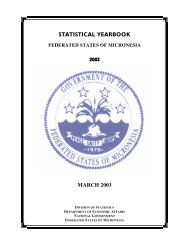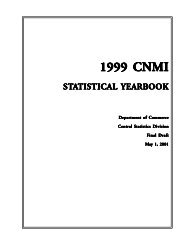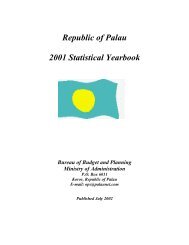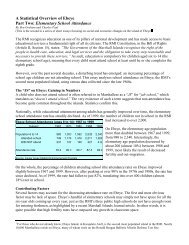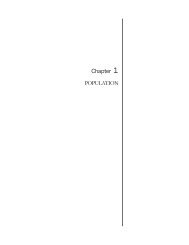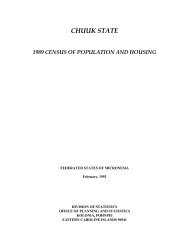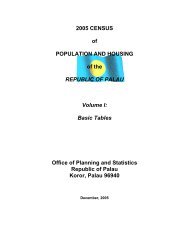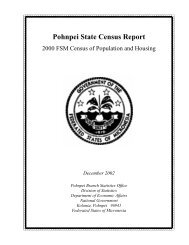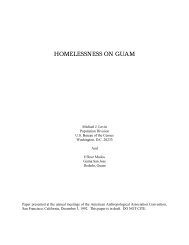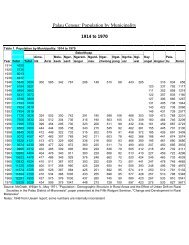Chapter 2. Age and Sex Structure2000 FSM <strong>Census</strong> of <strong>Chuuk</strong> <strong>State</strong>1994 structure and 2000, where the length of the bars at ages 0-4 and 5-9 narrowed considerably compared to the barsfor the same ages for 1973 to 1989 structures.Table 2.3 shows the distribution of the <strong>Chuuk</strong> population by five-year age group and sex for 1994 and 2000 <strong>Census</strong>es.The distribution showed that the older the age group, the smaller the proportion. This pattern was true for both 1994and 2000. For instance, in 2000 14 percent of the population were below 5 years and 1.2 percent were aged 75 andabove. This decline with age reflects the effect of mortality and some migration. A similar pattern is also foundbetween the sexes, though at different levels.Table 2.3: Population by Age Group and Sex, <strong>Chuuk</strong> <strong>State</strong>: 1994 and 20001994 2000Number Percent Number PercentAge groups Total Males Females Total Males Females Total Males Females Total Males FemalesTotal 53,319 27,299 26,020 100.0 100.0 100.0 53,595 27,158 26,437 100.0 100.0 100.0Less than 5 yrs 8,440 4,388 4,052 15.8 16.1 15.6 7,347 3,742 3,605 13.7 13.8 13.65 to 9 years 8,100 4,269 3,831 15.2 15.6 14.7 7,305 3,735 3,570 13.6 13.8 13.510 to 14 years 7,711 3,955 3,756 14.5 14.5 14.4 7,356 3,899 3,457 13.7 14.4 13.115 to 19 years 6,063 3,208 2,855 11.4 11.8 11.0 6,772 3,429 3,343 12.6 12.6 12.620 to 24 years 4,452 2,238 2,214 8.3 8.2 8.5 4,836 2,566 2,270 9.0 9.4 8.625 to 29 years 3,471 1,763 1,708 6.5 6.5 6.6 3,998 1,966 2,032 7.5 7.2 7.730 to 34 years 3,171 1,566 1,605 5.9 5.7 6.2 3,151 1,580 1,571 5.9 5.8 5.935 to 39 years 2,858 1,432 1,426 5.4 5.2 5.5 2,847 1,396 1,451 5.3 5.1 5.540 to 44 years 2,454 1,257 1,197 4.6 4.6 4.6 2,571 1,278 1,293 4.8 4.7 4.945 to 49 years 1,764 917 847 3.3 3.4 3.3 2,225 1,124 1,101 4.2 4.1 4.250 to 54 years 990 495 495 1.9 1.8 1.9 1,560 769 791 2.9 2.8 3.055 to 59 years 1,028 495 533 1.9 1.8 2.0 851 407 444 1.6 1.5 1.760 to 64 years 943 495 448 1.8 1.8 1.7 831 392 439 1.6 1.4 1.765 to 69 years 701 319 382 1.3 1.2 1.5 720 336 384 1.3 1.2 1.570 to 74 years 611 280 331 1.1 1.0 1.3 478 217 261 0.9 0.8 1.075 yrs & over 562 222 340 1.1 0.8 1.3 747 322 425 1.4 1.2 1.6Source: 1994 FSM <strong>Census</strong>, Table P13; 2000 FSM <strong>Census</strong>, Table P2-1.Median AgeThe median age is a measure that divides the population into two equal parts (the age at which half of the population isolder and half is younger). Change in the median age shows if the population is aging or growing younger. Themedian age is especially useful as one measurement when comparing the composition of a population over time and toother populations.The median age increased by about two years in the 27 years before the 2000 <strong>Census</strong>, indicating that the <strong>Chuuk</strong>population is aging (Table 2.4). From 1973 to 2000 the median age for both males and females increased by two years.The median age varied geographically in <strong>Chuuk</strong> in the last census, as well as the census years before that. Over thethree decades observed, the Lagoon median age increased by 1 years while the median age for the outer islandsincreased by 4 years. This shows that the Outer Island population had aged. The median ages for both the Lagoon andthe Outer Islands in 2000 was about 19 years.Table 2.4: Median Age by Municipality and Sex, <strong>Chuuk</strong> <strong>State</strong>: 1973 to 2000Total Males FemalesRegion1973 1980 1989 1994 2000 1973 1980 1989 1994 2000 1973 1980 1989 1994 2000Total 16.5 16.7 15.8 17.0 18.5 16.1 16.1 15.1 16.6 18.2 17.0 17.2 16.7 17.4 18.9Lagoon 16.9 16.5 16.0 16.9 18.3 16.8 16.0 15.4 16.6 18.0 17.2 17.0 16.7 17.2 18.7N. Namoneas 18.5 17.7 17.4 18.1 19.5 18.6 17.4 17.1 18.2 19.4 18.5 18.0 17.7 17.9 19.6S. Namoneas 15.0 16.2 15.1 16.4 18.1 14.9 15.5 14.5 15.8 18.4 15.8 16.9 16.0 17.1 18.7Faichuk 15.4 15.2 14.7 15.5 17.1 15.1 14.8 14.1 15.0 16.7 15.9 15.9 15.4 16.1 17.6Outer Islands 15.2 17.2 14.9 17.3 19.3 14.1 16.5 14.0 16.5 19.1 16.9 17.9 16.6 18.2 19.4Mortlocks 15.6 17.4 15.4 17.9 19.9 14.4 16.6 14.1 17.0 19.7 17.4 18.3 17.5 18.9 20.2Pattiw 14.2 17.8 13.9 16.8 18.9 13.2 16.9 12.4 15.7 18.3 15.0 18.6 16.3 18.1 19.5Namonuito 16.4 16.7 15.3 14.4 16.3 15.8 16.4 15.1 13.8 16.4 17.2 17.2 15.4 15.2 16.1Halls 13.6 15.3 14.4 17.6 19.8 12.3 15.5 14.1 17.4 19.9 15.5 15.1 14.7 17.9 19.6Source: 1973 TTPI <strong>Census</strong>, T4a; 1980 TTPI <strong>Census</strong>; 1989 <strong>Chuuk</strong> <strong>Census</strong>; 1994 FSM <strong>Census</strong>, Table P13; 2000 FSM <strong>Census</strong>, Table P2-1.Sex RatioThe sex ratio (number of males per 100 females) for <strong>Chuuk</strong> had dropped from about 105 to 103 over the two decadesbefore the censuses illustrated in Table 2.5. In 1973 the regions in the Outer Islands had a feminine population whereasregions in the Lagoon had rather masculine ones. However, in 2000 both areas display a rather masculine population.22 <strong>Chuuk</strong> Branch Statistics Office, Division of Statistics, FSM Department of Economic Affairs
2000 FSM <strong>Census</strong> of <strong>Chuuk</strong> <strong>State</strong>Chapter 2. Age and Sex StructureTable 2.5: Males per Females by Municipality, <strong>Chuuk</strong> <strong>State</strong>: 1973 to 2000<strong>Census</strong> YearsAge groups 1973 1980 1989 1994 2000Total 104.5 105.5 102.3 104.9 102.7Lagoon 107.0 107.1 102.9 105.7 103.3N. Namoneas 112.0 109.7 100.5 107.2 100.8S. Namoneas 103.2 106.2 104.3 104.5 105.7Faichuk 104.6 104.9 104.7 104.7 104.0Outer Islands 95.7 100.6 99.9 102.3 100.9Mortlocks 96.3 101.1 102.1 99.8 101.5Oksoritod (Western Islands) 97.6 101.6 107.7 105.5 100.2Source: 1973 TTPI <strong>Census</strong>, T4a; 1980 TTPI <strong>Census</strong>, 1999 <strong>Chuuk</strong> <strong>Census</strong>; 1994 FSM <strong>Census</strong>, Table P13; 2000 FSM <strong>Census</strong>, Table P2-1.The <strong>Chuuk</strong> sex ratio decreased from about 105 in 1994 to 103 in the year 2000 (Table 2.6). In most societies moremales are born than females, therefore the excess of males at the young ages of 0 to 9 in 1994 and 2000 is notsurprising. The shortage of males in 2000 is especially evident at ages 35 to 39, 40 to 44 and 50 years and older. Theshortage of males for ages 35 to 39 may be attributed to emigration, while the shortage of males at ages 50 and oldermay be explained by a combined effect of emigration and mortality (the tendency for males to die younger thanfemales, resulting in the excess of females in the older age groups). The Southern Namoneas had the highest sex ratioof 106, while the Oksoritod (Western Islands) had the lowest at 100.Table 2.6: Males per Females by Age Group and Municipality, <strong>Chuuk</strong> <strong>State</strong>: 1994 and 20001994 2000Age groupTotalN. NamoneasS. NamoneasFaichuk Mortlocks Oksoritod TotalN. NamoneasS. NamoneasFaichuk Mortlocks OksoritodTotal 104.9 107.2 104.5 104.7 99.8 105.5 102.7 100.8 105.7 104.0 101.5 100.2Less than 5 yrs 108.3 103.0 111.1 114.2 99.6 113.1 103.8 104.1 114.3 108.6 96.2 83.95 to 9 years 111.4 112.1 113.5 110.7 110.3 107.9 104.6 103.3 109.9 103.5 98.4 107.410 to 14 years 105.3 98.9 107.3 103.4 109.2 121.8 112.8 111.1 115.2 116.2 105.3 113.815 to 19 years 112.4 110.4 111.6 118.0 116.8 104.0 102.5 91.3 109.7 102.7 118.3 107.820 to 24 years 101.1 105.0 98.1 107.2 88.7 94.3 113.2 109.5 119.1 110.4 133.9 102.225 to 29 years 103.2 112.3 93.2 98.0 101.5 109.3 96.6 92.8 100.0 100.7 94.5 93.830 to 34 years 97.6 102.7 99.7 89.7 96.0 96.0 100.4 104.1 90.6 100.0 98.9 113.335 to 39 years 100.4 107.4 94.2 97.0 118.4 81.5 96.4 97.4 88.7 99.1 94.1 106.140 to 44 years 105.0 119.8 92.4 93.7 101.5 113.5 98.8 95.2 110.9 90.9 106.7 94.745 to 49 years 108.3 128.5 100.0 76.3 108.6 141.4 102.1 100.9 100.0 98.4 118.3 96.550 to 54 years 100.0 96.1 102.8 114.0 72.6 126.2 97.2 104.0 94.7 80.2 104.0 114.955 to 59 years 92.9 110.4 95.5 83.5 81.0 68.0 91.7 92.9 84.1 96.5 77.5 132.360 to 64 years 110.5 129.5 109.0 109.3 76.3 123.3 89.3 90.5 95.2 93.8 82.5 73.865 to 69 years 83.5 76.0 118.8 72.2 71.8 79.4 87.5 88.6 78.2 116.7 70.7 80.570 to 74 years 84.6 85.9 89.0 100.0 71.0 67.6 83.1 124.0 104.1 78.7 54.7 56.875 yrs & over 85.3 100.0 59.5 77.2 44.2 53.5 75.8 88.0 66.7 90.0 61.3 62.3Source: 1994 FSM <strong>Census</strong>, Table P13; 2000 FSM <strong>Census</strong>, Table P2-1.Dependency RatioThe dependency ratio measures the degree of economic ease or hardship inherent in a given age-sex structure.However, it is only an index since it assumes certain age-groups exclusively as "producers" or "consumers". Thedependency ratio is the sum of the population below 15 and 65 years and over (defined as the dependent age-groups),divided by the sum of the population aged 15 to 64. Often the dependency ratio is divided into old dependency (ratioof those 65 years and over to those ages 15 to 64) and young dependency (ratio of those under 15 to those ages 15 to64). The dependency ratio should not be confused with the economically active ratio. The former considers all personsof working age, while the latter considers only those individuals of working age who are economically active, which isusually less than the dependency ratio (see Chapter 9).In 2000, the dependency ratio of <strong>Chuuk</strong> was about 81 (meaning that for every 100 persons of working-age, there are 81consumers in terms of food, clothing, shelter, and so forth). The dependency ratio decreased by 14.4 percentage pointsfrom 1994. This decline shows a relative increase in the working age population (Table 2.7). The young dependencyratio in 2000 was 74.2 and the old age dependency ratio was about 6.6, showing that the dependency burden wasparticularly among the young. The young dependency ratio decline by 19.4 percentage points over the three decadebefore the 2000 census, as a result of the decline in fertility. The old dependency ratio declined by 2 percentage pointsover the same period.Among the regions in <strong>Chuuk</strong>, the highest dependency ratio in 2000 was in Namonwito (which also had one of thehighest fertility rate), and lowest in Northern Namoneas (with one of the lowest fertility rate), showing the role offertility in the shifting of the dependency ratio in <strong>Chuuk</strong>. The decline in the dependency ratio in the regions over thetwo decades stemmed from declining fertility and age-selective immigration.<strong>Chuuk</strong> Branch Statistics Office, Division of Statistics, FSM Department of Economic Affairs 23
- Page 5: iii
- Page 12 and 13: Preface2000 FSM Census of Chuukx
- Page 14 and 15: Table of contents2000 FSM Census of
- Page 16 and 17: LIST OF TEXT TABLESTABLEPageChapter
- Page 18 and 19: List of Text Table2000 FSM Census o
- Page 20 and 21: LIST OF FIGURESFIGUREPageFigure 1.1
- Page 22 and 23: List of Basic-Tables2000 FSM Census
- Page 24 and 25: MAP OF FSMxxiiChuuk Branch Statisti
- Page 27 and 28: 2000 FSM Census of Chuuk StateExecu
- Page 29 and 30: CHAPTER 1INTRODUCTIONThe creation o
- Page 31 and 32: 2000 FSM Census of Chuuk StateChapt
- Page 33 and 34: 2000 FSM Census of Chuuk StateChapt
- Page 35 and 36: 2000 FSM Census of Chuuk StateChapt
- Page 37 and 38: 2000 FSM Census of Chuuk StateChapt
- Page 39 and 40: 2000 FSM Census of Chuuk StateChapt
- Page 41 and 42: 2000 FSM Census of Chuuk StateChapt
- Page 43 and 44: 2000 FSM Census of Chuuk State Chap
- Page 45: 2000 FSM Census of Chuuk StateChapt
- Page 48 and 49: Chapter 2. Age and Sex Structure200
- Page 52 and 53: Chapter 2. Age and Sex Structure200
- Page 55 and 56: CHAPTER 3HOUSEHOLDS, FAMILIES, AND
- Page 57 and 58: 2000 FSM Census of Chuuk StateChapt
- Page 59 and 60: 2000 FSM Census of Chuuk StateChapt
- Page 61: 2000 FSM Census of Chuuk StateChapt
- Page 64 and 65: Chapter 4. Fertility2000 FSM Census
- Page 66 and 67: Chapter 4. Fertility2000 FSM Census
- Page 68 and 69: Chapter 4. Fertility2000 FSM Census
- Page 71 and 72: CHAPTER 5MORTALITYIntroductionAs re
- Page 73 and 74: 2000 FSM Census of Chuuk StateChapt
- Page 75: 2000 FSM Census of Chuuk StateChapt
- Page 78 and 79: Chapter 6. Migration2000 FSM Census
- Page 80 and 81: Chapter 6. Migration2000 FSM Census
- Page 82 and 83: Chapter 6. Migration2000 FSM Census
- Page 84 and 85: Chapter 6. Migration2000 FSM Census
- Page 86 and 87: Chapter 7. Religion, Ethnicity, and
- Page 88 and 89: Chapter 7. Religion, Ethnicity, and
- Page 90 and 91: Chapter 7. Religion, Ethnicity, and
- Page 92 and 93: Chapter 8. Education2000 FSM Census
- Page 94 and 95: Chapter 8. Education2000 FSM Census
- Page 96 and 97: Chapter 8. Education2000 FSM Census
- Page 98 and 99: Chapter 8. Education2000 FSM Census
- Page 100 and 101:
Chapter 8. Education2000 FSM Census
- Page 103 and 104:
CHAPTER 9ECONOMIC ACTIVITYIntroduct
- Page 105 and 106:
2000 FSM Census of Chuuk StateChapt
- Page 107 and 108:
2000 FSM Census of Chuuk StateChapt
- Page 109 and 110:
2000 FSM Census of Chuuk StateChapt
- Page 111 and 112:
2000 FSM Census of Chuuk StateChapt
- Page 113 and 114:
2000 FSM Census of Chuuk StateChapt
- Page 115 and 116:
2000 FSM Census of Chuuk StateChapt
- Page 117 and 118:
CHAPTER 10INDUSTRY AND OCCUPATIONIn
- Page 119 and 120:
2000 FSM Census of Chuuk StateChapt
- Page 121 and 122:
2000 FSM Census of Chuuk StateChapt
- Page 123 and 124:
2000 FSM Census of Chuuk StateChapt
- Page 125 and 126:
2000 FSM Census of Chuuk StateChapt
- Page 127 and 128:
2000 FSM Census of Chuuk StateChapt
- Page 129 and 130:
CHAPTER 11INCOMEIntroductionThe 200
- Page 131 and 132:
2000 FSM Census of Chuuk StateChapt
- Page 133 and 134:
2000 FSM Census of Chuuk StateChapt
- Page 135 and 136:
2000 FSM Census of Chuuk StateChapt
- Page 137:
2000 FSM Census of Chuuk StateChapt
- Page 140 and 141:
Chapter 12. Housing2000 FSM Census
- Page 142 and 143:
Chapter 12. Housing2000 FSM Census
- Page 144 and 145:
Chapter 12. Housing2000 FSM Census
- Page 146 and 147:
Chapter 12. Housing2000 FSM Census
- Page 148 and 149:
Chapter 12. Housing2000 FSM Census
- Page 150 and 151:
Chapter 12. Housing2000 FSM Census
- Page 152 and 153:
Chapter 12. Housing2000 FSM Census
- Page 154:
Chapter 12. Housing2000 FSM Census
- Page 157 and 158:
BIBLIOGRAPHYArriaga, E.E., (1983).
- Page 159:
2000 FSM Census of Chuuk StateBibli
- Page 162 and 163:
Basic Tables2000 FSM Census of Chuu
- Page 164 and 165:
Basic Tables2000 FSM Census of Chuu
- Page 166 and 167:
Basic Tables2000 FSM Census of Chuu
- Page 168 and 169:
Basic Tables2000 FSM Census of Chuu
- Page 170 and 171:
Basic Tables2000 FSM Census of Chuu
- Page 172 and 173:
Basic Tables2000 FSM Census of Chuu
- Page 174 and 175:
Basic Tables2000 FSM Census of Chuu
- Page 176 and 177:
Basic Tables2000 FSM Census of Chuu
- Page 178 and 179:
Basic Tables2000 FSM Census of Chuu
- Page 180 and 181:
Basic Tables2000 FSM Census of Chuu
- Page 182 and 183:
Basic Tables2000 FSM Census of Chuu
- Page 184 and 185:
Basic Tables2000 FSM Census of Chuu
- Page 186 and 187:
Basic Tables2000 FSM Census of Chuu
- Page 188 and 189:
Basic Tables2000 FSM Census of Chuu
- Page 190 and 191:
Basic Tables2000 FSM Census of Chuu
- Page 192 and 193:
Basic Tables2000 FSM Census of Chuu
- Page 194 and 195:
Basic Tables2000 FSM Census of Chuu
- Page 196 and 197:
Basic Tables2000 FSM Census of Chuu
- Page 198 and 199:
Basic Tables2000 FSM Census of Chuu
- Page 200 and 201:
Basic Tables2000 FSM Census of Chuu
- Page 202 and 203:
Basic Tables2000 FSM Census of Chuu
- Page 204 and 205:
Basic Tables2000 FSM Census of Chuu
- Page 206 and 207:
Basic Tables2000 FSM Census of Chuu
- Page 208 and 209:
Basic Tables2000 FSM Census of Chuu
- Page 210 and 211:
Basic Tables2000 FSM Census of Chuu
- Page 212 and 213:
Basic Tables2000 FSM Census of Chuu
- Page 214 and 215:
Basic Tables2000 FSM Census of Chuu
- Page 216 and 217:
Basic Tables2000 FSM Census of Chuu
- Page 218 and 219:
Basic Tables2000 FSM Census of Chuu
- Page 220 and 221:
Basic Tables2000 FSM Census of Chuu
- Page 222 and 223:
Basic Tables2000 FSM Census of Chuu
- Page 224 and 225:
Basic Tables2000 FSM Census of Chuu
- Page 226 and 227:
Basic Tables2000 FSM Census of Chuu
- Page 228 and 229:
Basic Tables2000 FSM Census of Chuu
- Page 230 and 231:
Basic Tables2000 FSM Census of Chuu
- Page 232 and 233:
Basic Tables2000 FSM Census of Chuu
- Page 234 and 235:
Basic Tables2000 FSM Census of Chuu
- Page 236 and 237:
Basic Tables2000 FSM Census of Chuu
- Page 238 and 239:
Basic Tables2000 FSM Census of Chuu
- Page 240 and 241:
Basic Tables2000 FSM Census of Chuu
- Page 242 and 243:
Basic Tables2000 FSM Census of Chuu
- Page 244 and 245:
Basic Tables2000 FSM Census of Chuu
- Page 246 and 247:
Basic Tables2000 FSM Census of Chuu
- Page 248 and 249:
Basic Tables2000 FSM Census of Chuu
- Page 250 and 251:
Basic Tables2000 FSM Census of Chuu
- Page 252 and 253:
Basic Tables2000 FSM Census of Chuu
- Page 254 and 255:
Basic Tables2000 FSM Census of Chuu
- Page 256 and 257:
Basic Tables2000 FSM Census of Chuu
- Page 258 and 259:
Basic Tables2000 FSM Census of Chuu
- Page 260 and 261:
Basic Tables2000 FSM Census of Chuu
- Page 262 and 263:
Basic Tables2000 FSM Census of Chuu
- Page 264 and 265:
Basic Tables2000 FSM Census of Chuu
- Page 266 and 267:
Basic Tables2000 FSM Census of Chuu
- Page 268 and 269:
Basic Tables2000 FSM Census of Chuu
- Page 270 and 271:
Basic Tables2000 FSM Census of Chuu
- Page 272 and 273:
Basic Tables2000 FSM Census of Chuu
- Page 274 and 275:
Basic Tables2000 FSM Census of Chuu
- Page 276 and 277:
Basic Tables2000 FSM Census of Chuu
- Page 278 and 279:
Basic Tables2000 FSM Census of Chuu
- Page 280 and 281:
Basic Tables2000 FSM Census of Chuu
- Page 282 and 283:
Basic Tables2000 FSM Census of Chuu
- Page 284 and 285:
Basic Tables2000 FSM Census of Chuu
- Page 286 and 287:
Basic Tables2000 FSM Census of Chuu
- Page 288 and 289:
Basic Tables2000 FSM Census of Chuu
- Page 290 and 291:
Basic Tables2000 FSM Census of Chuu
- Page 292 and 293:
Questionnaire2000 FSM Census of Chu
- Page 294 and 295:
Questionnaire2000 FSM Census of Chu
- Page 296 and 297:
Questionnaire2000 FSM Census of Chu



